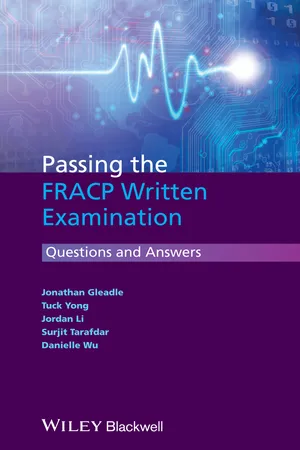
Passing the FRACP Written Examination
Questions and Answers
- English
- ePUB (mobile friendly)
- Available on iOS & Android
Passing the FRACP Written Examination
Questions and Answers
About This Book
Passing the FRACP Written Examination is the ideal study aid for candidates of the Fellow of the Royal Australasian College of Physicians (FRACP) examination. Written by a team of physicians based at Flinders Medical Centre, and covering the key components of the FRACP basic training syllabus, this guide presents over 500 multiple-choice questions on all major topics covered in the examination. It provides coverage of rapidly evolving topics such as healthcare in an ageing population, disparity in indigenous health outcomes, advances in molecular science and genetics, and the complexity of care arising from multiple chronic illnesses. Questions echo the written examination, including those on both 'Basic Sciences' and 'Clinical Practice'. Many of the questions are similar to those in the actual examination; others are designed to 'teach' particularly important issues or to draw attention to contemporary topics. Each question has an answer that fully explains the correct and incorrect responses.
This study aid also includes:
•Questions and answers linked to a reference that is usually the best and most contemporary review for further reading and as additional guide to study
•QR code links to all the references
•Hints and tips from previous candidates on examination strategies
•A large number of the new style extended matching questions (EMQs).
This brand new study aid gives all FRACP candidates a unique opportunity to practise for the examination and improve their medical knowledge of the syllabus as a whole.
Frequently asked questions
Information
Basic Science
Theme: Beta-blockers (for Questions 7 and 8)
Clinical

Table of contents
- Cover
- Title page
- Copyright page
- Introduction
- Acknowledgements
- Features contained in your study aid
- 1: Cardiology
- 2: Respiratory and sleep medicine
- 3: Gastroenterology
- 4: Nephrology
- 5: Endocrinology
- 6: Neurology
- 7: Rheumatology
- 8: Dermatology
- 9: Oncology
- 10: Infectious diseases
- 11: Haematology
- 12: Clinical immunology
- 13: Clinical pharmacology
- 14: Clinical genetics
- 15: General medicine, geriatric medicine and other topics
- 16: Psychiatry
- 17: Statistics, epidemiology and research
- 18: Intensive care medicine
- Index